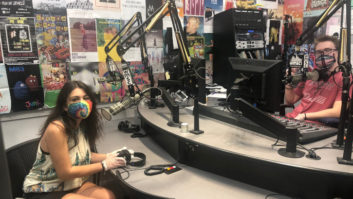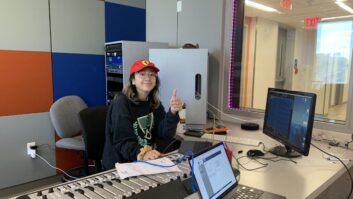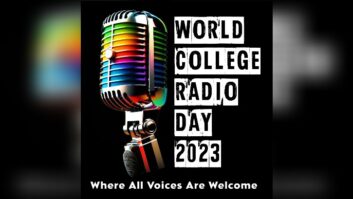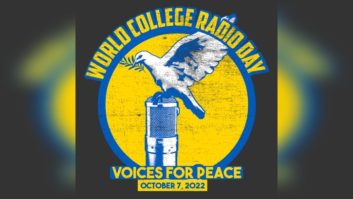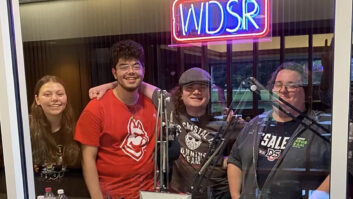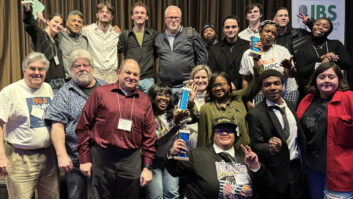Sean McDonald, director of Neumann Media at Neumann University in Aston, Pa., is in charge of both the university’s radio and television stations. He also is the chief engineer of the studios, and supports all communication classes, media programs and live streaming for the university. He said that, for many students in the communications/broadcasting program, 2020 and the pandemic have given them the opportunity for a hands-on experience that equals an internship.
Radio World: Please describe your media operations, including the physical plant. How many studios, and how are they equipped? Where is the transmission facility; how is it equipped?
Sean McDonald: Neumann Media is housed in the John J. Mullen Jr. Communication Center, a recently built $5 million, 10,000-square foot addition to the Bruder Life Center. Our facilities feature three radio studios, two Wenger Room editing bays, two television studios with control rooms, master control, an esports room, a multipurpose hall, green room, meeting space and a rental shop. All rooms in the building have copper ins and outs being sent to a Blackmagic Design 72×72 router. Each room also is a part of our Axia AoIP network.
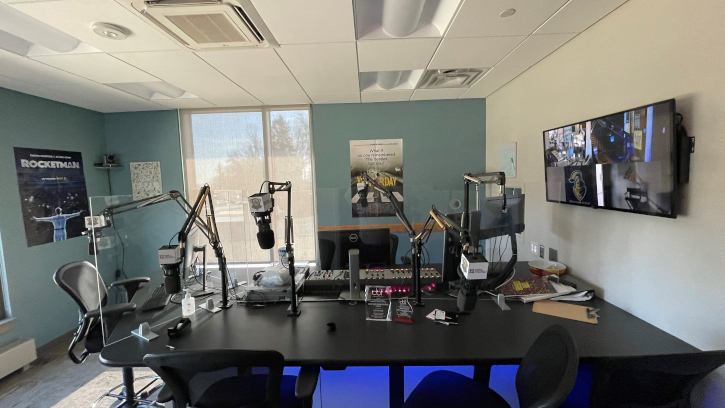
Studio A has an Axia Fusion and six AKG C414 microphones. Each studio runs RCS Zetta for playout. Pathfinder handles GPIO through a custom button panel on the Fusion, with commands for arming various studios for air, routing a VMix virtual mix to air during production periods, as well as changing the state of the automation system, play next and a custom change chain button. The studio has a PC with an Axia IP Audio Driver, and the Adobe Creative Cloud suite. There are four Comrex Access Rack codecs that can be routed into the studio to use for remotes or to connect with some of our sister stations, like 90.3 WMSC at Montclair State University. There is also a television mounted on the wall with the ability to route different camera feeds of the various studios to the television. All audio goes to master control and is processed through the 25-Seven PDM program delay manager.
Studio B has an Axia iQ console, with the same button panels configured as the Fusion in Studio A. There are two Shure SM7Bs in Studio B, with swappable AKG C414s stored in the room. The studio has a production PC with an Axia IP Audio Driver and the Adobe Creative Cloud suite.
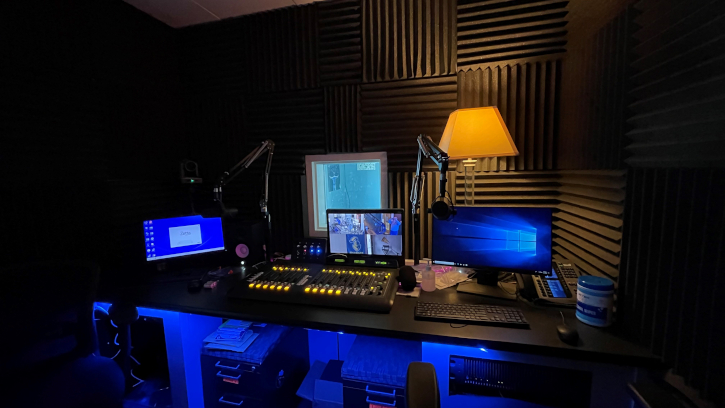
Studio C has an Axia Desq console. There is a Neumann BCM 705 and a Symetrix 528E Processor in the studio. The studio has a production PC with an Axia IP Audio Driver, and the Adobe Creative Cloud suite.
Each Wenger Edit room is equipped with an Axia Raq console, a production PC with an Axia IP Audio Driver and the Adobe Creative Cloud Suite.
The PDM audio in master controls exits through an analog node and is sent to the transmitter using a Comrex Access Rack as our STL. Our backup unit is a Barix InStreamer, and our stream is encoded using the Telos ProStream. The Telos VMix in master control integrates through the phone panel on the Fusion and through VSet handsets in the other studios and edit bays.
The transmitter site is one mile away from campus and features a Nautel VS300 as the transmitter. Workflow at the transmitter begins with the Comrex Access Rack and Barix Extremer receiving audio from the studio. An iPod with emergency backup music is also playing at all times at the transmitter. All audio goes into an Axia Analog Node; another Pathfinder Server routes the audio to air. The Access gets priority, followed by the Barix and then the iPod. The audio then is processed through an Omnia.One, and is fed through a Digital Alert Systems DASDEC as the final stage before hitting the transmitter.
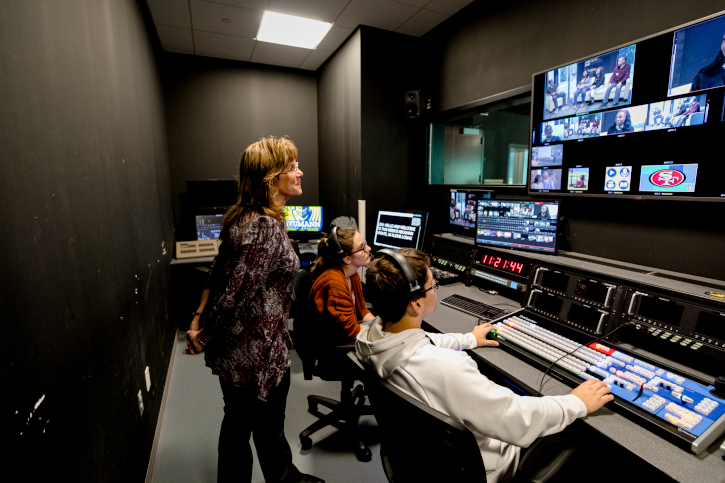
Our two TV studios and sports arena are each equipped with a NewTek TriCaster 8000 video production system running Advanced Edition. Our studio cameras are Panasonic P2s with AutoCue teleprompters, tally lights, Atomos Ninjas for studio monitors and RTS Audiocom intercom. We have a Soundcraft SI Expression 3 audio mixer in the main television studio and a Soundcraft SI Expression 2 in our secondary studio and sports arena. As mentioned, we use a BMD 72×72 router to send ins and outs throughout the building. We use NDI [Network Device Interface] sources like computers to bring guests in virtually, and to produce high-quality Zoom/Teams conferences when necessary. For remote guests who are able to connect with us, we have two Comrex LiveShot units and a ReadyCam Encoder. In many ways, we built this infrastructure for the future; we just didn’t know the future was operating in a pandemic.
RW: Who makes the executive decisions for the station? What role do the students have in station operations? What types of programming do they produce?
McDonald: As the director of the program, I make the executive decisions for the station with direct input form my student staff. Our students make up a student leadership team for radio and television: program director, news director, music directors, student engineer, news director and production director. Because we are both radio and TV, our students are active in both areas, so they lend their expertise to both programs to give themselves a well-rounded experience.
Our radio station has a wide range of programming, including specialty sports programming (all hockey, all basketball, Philly sports, etc.), a Hispanic music hour, a Hispanic culture hour, a positive/praise hour and so much more. My students really embrace the idea that college radio is the training ground for their future, and the space where music is discovered and given a chance. From ’50s jazz to K-Pop, we run the gamut of musical genres, which really makes us feel like we are “Radio Re-Invented.”
RW: Are students on campus now or learning and operating remotely?
McDonald: Neumann University [originally] operated on a hybrid method. Our students had the choice to come in-person, do classes fully remotely either live or asynchronous, or do a mixture of both. Classes were socially distanced with seating, and where needed, a rotation was created to let as many students as possible who wanted an in-person experience to have it. We went fully online for the remainder of the semester effective Nov. 16, 2020, five days earlier than originally anticipated.
RW: Is the station currently on the air? What means and products (e.g. software or hardware) are being used?
McDonald: The station is currently on the air, and shows are continuing both in person and remotely. Throughout the pandemic, we have been using a variety of software and hardware to get on the air, and it has given us a lot of great options. At the start of the pandemic, I bought a bunch of Blue USB Snowball Mics and PreSonus Audiobox USB 96 boxes to send home with students for classes and for radio shows. A few faculty and staff members are also using these to do their radio shows remotely.
We have multiple Comrex Access Rack units and portable units, so when we need a quick hit on the air, I typically let the students use the Fieldtap app if they have a decent enough Wi-Fi connection.
We have been using Zetta2Go via VPN for voice tracking of shows, or letting students use the interface to control the air machine’s stack and log, while being brought in on some form of codec.
The software we are currently using to get people on the air includes Audiomovers Listento, Cleanfeed, Discord, Microsoft Teams and Zoom.
RW: What impact has COVID-19 had on the station? What are the challenges due to social distancing?
McDonald: When our building was in the design phase, we made sure that every room had audio and video inputs and outputs because we did not know when we would need to use each room differently. I had planned with the future in mind. I just did not realize the future meant social distancing during a pandemic. Because of health guidelines, we had to limit the number of people allowed in each studio. Some of our shows had up to six people on it, so we had to figure out a way to safely allow the shows to meet, while not losing quality, and most importantly, not letting the audience in on the secret.
[Read: College Media Spotlight: University of Nebraska, Omaha]
I installed PTZ cameras in each of our studios and editing suites, and using our classroom studio’s TriCaster 8000, I created a quad box that had each camera feed in it. We put monitors in each of the studios so each studio could see the other in real time. Being an Axia plant, I created a COVID VMix on the Fusion’s Power Station for each of the studios, so when in a break, each studio could talk to each other without having to leave the room. The biggest test for this came on College Radio Day, when we had to social distance 15 people across six rooms. It worked flawlessly, and now it’s very simple for the students to switch to the “Social Distance” profile in the main studio and be able to do their show with ease.
For TV, we capitalized on the addition of PTZ’s in our editing suites and doubled them as remote sites for our TV shows. Our show “Intern TV” has three hosts (who have all lived together), which we can easily socially distance, but guests presented a challenge. We did not want to have four people spread out across the room, so we put the guests in the Wenger Room. Using an Axia Analog Node, we send a mix/minus to the Raq to hear the studio, and we take the guest’s audio into the IEM of our hosts. The hosts sit in a semi-circle around a large TV that has a static shot of our guest, making the visual connection for the audience that they are still doing this live, just with a little distance between them. We adopted this model for our news program as well, which has worked well.
Technology is so good now that we were always prepared to do this, but never actively had a reason to utilize the workflow. The biggest challenge has been getting the students used to not having people physically next to them. It took a few weeks, but this is now just another tool in the student’s toolbox. Of course, there are small challenges that arise, like when one of our anchors was placed in quarantine after a possible exposure. Instead of cancelling the show, we took advantage of the fact that Microsoft Teams has become NDI-compliant. Using NDI, we put our anchor into our TriCaster like any other camera, and we fed the anchor the prompter as our camera feed, and the show continued just like any other week.
2020 taught us to be ready for anything, and to adapt on the fly. I am really proud of the way my students have powered through this, and I truly believe they will be better broadcasters because of these experiences.
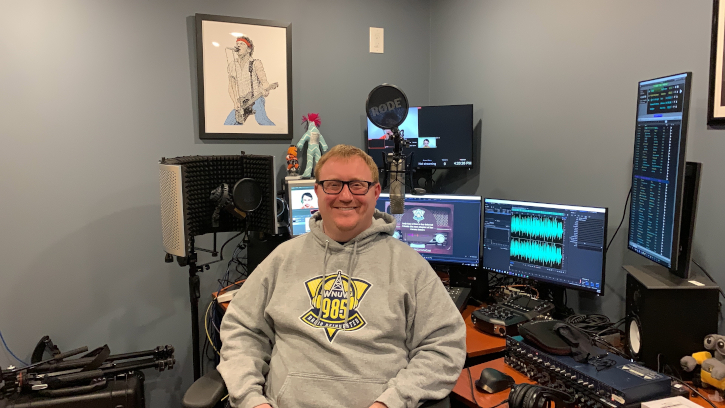
RW: If the students are operating remotely, how are you making that happen? Can you give examples?
McDonald: Live shows that are remote happen using Cleanfeed, Discord and Microsoft Teams. We are using Cleanfeed to bring hosts and guests into the studio. We use a PC with an Axia IP driver to get the studio computer to the console, and we feed our PGM4 bus to the machine for talkback. We use Discord and Microsoft Teams to chat type to each other during on-air breaks, share files/ info, etc. Our Wellness Center hosts a weekly wellness show completely remotely with students, a professional counselor and a board operator who is in Studio A, communicating and producing the show. At the moment, the “Wellness Wednesday” show is the only one that is remote. During the start of the pandemic, students would prerecord their shows through voice tracking with Zetta2Go for single jock shows. Shows with more than one host would use Discord or Cleanfeed to record the show, and then we would load it into Zetta via VPN.
RW: Is there anything else our readers should know?
McDonald: 2020 has been rough for everyone, but it has also been a learning experience for the professional broadcaster. Students studying communications/broadcasting may not have noticed that on March 13, 2020, everything about our industry changed. Suddenly, we weren’t able to go live from an insert studio with a ReadyCam for TV or a rental booth for radio to get on air. What was considered not broadcast quality on March 12 was suddenly acceptable because it is all that was available. Zoom became a tool to get an image to air, and we have become accustomed to AirPods as an IFB, and not very good audio quality.
My students took a week to mourn the loss of their in-person semester, and then got to work with me to figure out what was the next step. In writing the answers to this interview, I asked them about their experience, and they agreed that they learned more in the past eight months than they probably would have learned in their traditional classes and internships.
[Read: College Station Spotlight: Montclair State University]
At shutdown, items like monitors and webcams and USB microphones became a hot item on eBay because the supply was depleted. We had to figure out the best way to get on the air without breaking the bank or taxing our home internet bandwidth. For a few months, my students became mini broadcast engineers, figuring out how to use software and tools they have in their everyday lives as a way of broadcasting a signal over the internet and on the terrestrial airwaves. They figured a way to use gaming tools like Discord to conduct interviews with pop artists. Talking to our former students and friends in the industry, we discovered new tricks that previous investments could do. For example, a former student handles the Twitch account for 97.5 The Fanatic in Philadelphia. They were operating remotely, and started using their Livestream Studio’s remote guest feature, bringing up to five guests into their switcher using Google Chrome. We had an old box in storage, and we produced TV shows with it.
The students also learned more about IT and networking, as well as the functionality of a VPN and how to remote edit/voice track. We would normally talk about these things in theory of classes, but rarely would they get the opportunity to use it hands-on.
This pandemic has been the best hands-on experience next to an internship, because this form of broadcasting is going to stick around for a long time. Codecs will continue to be developed, equipment will go down in price, and guests will care about the @ratemyskyperoom account even more than ever, so they will buy artwork and proper lighting for their segment on TV. 2020 has prepared the next generation of broadcasters for broadcasting’s next generation. Fortunately for us, these students were embracing these technologies long before television and radio professionals thought to. The future of broadcasting is in great hands





